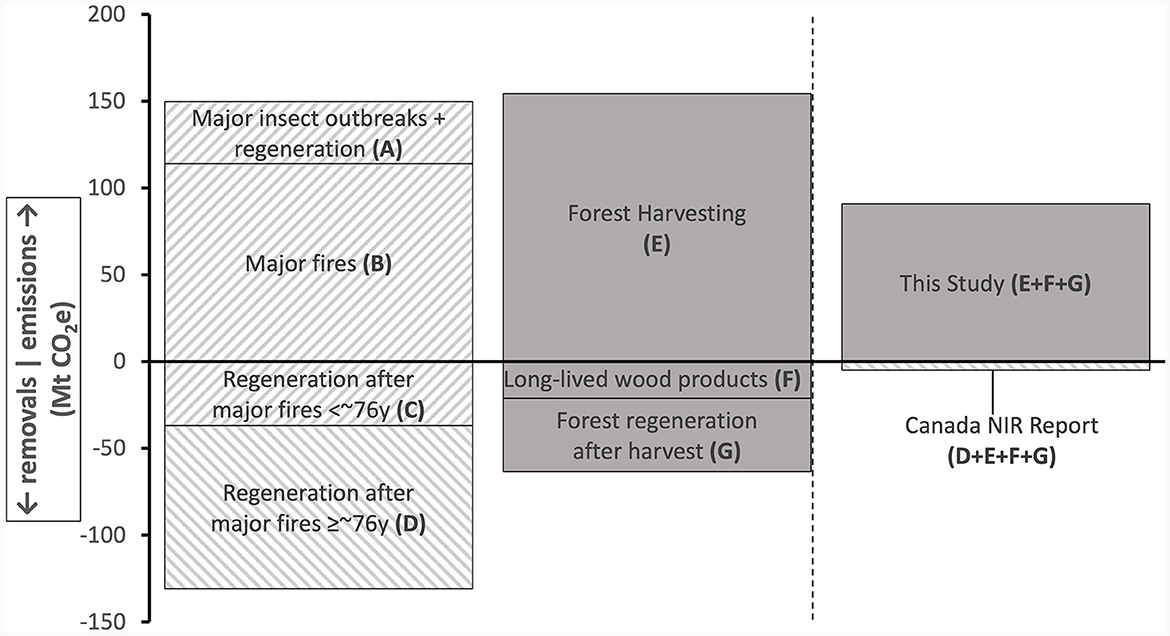
94% of researchers rate our articles as excellent or good
Learn more about the work of our research integrity team to safeguard the quality of each article we publish.
Find out more
CORRECTION article
Front. For. Glob. Change, 26 February 2024
Sec. Forests and the Atmosphere
Volume 7 - 2024 | https://doi.org/10.3389/ffgc.2024.1369184
This article is a correction to:
High emissions or carbon neutral? Inclusion of “anthropogenic” forest sinks leads to underreporting of forestry emissions
A corrigendum on
High emissions or carbon neutral? Inclusion of “anthropogenic” forest sinks leads to underreporting of forestry emissions
by Bysouth, D., Boan, J. J., Malcolm, J. R., and Taylor, A. R. (2024). Front. For. Glob. Change. 6:1297301. doi: 10.3389/ffgc.2023.1297301
In the published article, Bramley and Saul, 2022 was not cited in the article. The citation has now been inserted in 2.3, Paragraph 1 and should read:
“Our definition of annual net emissions associated with forestry comprises the sum of the flows that can reasonably be directly attributed to forestry activities on FLFL (see Bramley and Saul, 2022)”
In the published article, there was an error in Figure 5 as published. There was a minor change in input data to create the figure. The corrected Figure 5 and its caption **Figure 5. The components of forest carbon flows in Canada's NIR over the 16-year study period and their average values. The left-hand column shows major wildfires, insect outbreaks, and the subsequent removals from regrowth. The middle column shows emissions and removals directly attributable to forestry. The right column shows net calculations in this study and in Canada's NIR reporting. NIR emissions portray the managed forest as almost carbon neutral due to the NIR's disaggregation of significant natural disturbance emissions, while still including natural removals from forest regeneration and growth appear below.

Figure 5. The components of forest carbon flows in Canada's NIR over the 16-year study period and their average values. The left-hand column shows major wildfires, insect outbreaks, and the subsequent removals from regrowth. The middle column shows emissions and removals directly attributable to forestry. The right column shows net calculations in this study and in Canada's NIR reporting. NIR emissions portray the managed forest as almost carbon neutral due to the NIR's disaggregation of significant natural disturbance emissions, while still including natural removals from forest regeneration and growth.
The authors apologize for these errors and state that this does not change the scientific conclusions of the article in any way. The original article has been updated.
All claims expressed in this article are solely those of the authors and do not necessarily represent those of their affiliated organizations, or those of the publisher, the editors and the reviewers. Any product that may be evaluated in this article, or claim that may be made by its manufacturer, is not guaranteed or endorsed by the publisher.
Bramley, M. J., and Saul, G. (2022). Net Greenhouse Gas Emissions from Logging in Canada? Available online at: http://naturecanada.ca/report/what-are-net-ghg-emissions-from-logging-in-canada (accessed May 1, 2023).
Keywords: forest carbon, greenhouse gas emissions, national inventory reports, anthropogenic sinks, wildfire
Citation: Bysouth D, Boan JJ, Malcolm JR and Taylor AR (2024) Corrigendum: High emissions or carbon neutral? Inclusion of “anthropogenic” forest sinks leads to underreporting of forestry emissions. Front. For. Glob. Change 7:1369184. doi: 10.3389/ffgc.2024.1369184
Received: 19 January 2024; Accepted: 30 January 2024;
Published: 26 February 2024.
Edited and reviewed by: Mohammad Ibrahim Khalil, University College Dublin, Ireland
Copyright © 2024 Bysouth, Boan, Malcolm and Taylor. This is an open-access article distributed under the terms of the Creative Commons Attribution License (CC BY). The use, distribution or reproduction in other forums is permitted, provided the original author(s) and the copyright owner(s) are credited and that the original publication in this journal is cited, in accordance with accepted academic practice. No use, distribution or reproduction is permitted which does not comply with these terms.
*Correspondence: Julee J. Boan, ampib2FuQGxha2VoZWFkdS5jYQ==
Disclaimer: All claims expressed in this article are solely those of the authors and do not necessarily represent those of their affiliated organizations, or those of the publisher, the editors and the reviewers. Any product that may be evaluated in this article or claim that may be made by its manufacturer is not guaranteed or endorsed by the publisher.
Research integrity at Frontiers

Learn more about the work of our research integrity team to safeguard the quality of each article we publish.